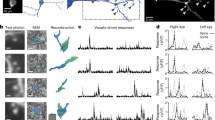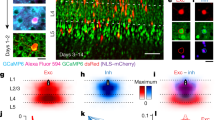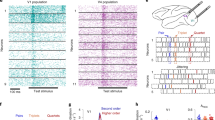Abstract
Excitatory cortical neurons form fine-scale networks of precisely interconnected neurons. Here we tested whether inhibitory cortical neurons in rat visual cortex might also be connected with fine-scale specificity. Using paired intracellular recordings and cross-correlation analyses of photostimulation-evoked synaptic currents, we found that fast-spiking interneurons preferentially connected to neighboring pyramids that provided them with reciprocal excitation. Furthermore, they shared common fine-scale excitatory input with neighboring pyramidal neurons only when the two cells were reciprocally connected, and not when there was no connection or a one-way, inhibitory-to-excitatory connection. Adapting inhibitory neurons shared little or no common input with neighboring pyramids, regardless of their direct connectivity. We conclude that inhibitory connections and also excitatory connections to inhibitory neurons can both be precise on a fine scale. Furthermore, fine-scale specificity depends on the type of inhibitory neuron and on direct connectivity between neighboring pyramidal-inhibitory neuron pairs.
This is a preview of subscription content, access via your institution
Access options
Subscribe to this journal
Receive 12 print issues and online access
$209.00 per year
only $17.42 per issue
Buy this article
- Purchase on Springer Link
- Instant access to full article PDF
Prices may be subject to local taxes which are calculated during checkout





Similar content being viewed by others
References
Felleman, D.J. & Van Essen, D.C. Distributed hierarchical processing in the primate cerebral cortex. Cereb. Cortex 1, 1–47 (1991).
Fitzpatrick, D. The functional organization of local circuits in visual cortex: insights from the study of tree shrew striate cortex. Cereb. Cortex 6, 329–341 (1996).
Martin, K.A.C. in Cerebral Cortex, Vol. 2. (eds. Jones, E.G. & Peters, A.) 241–284 (Plenum, New York, 1984).
Mooser, F., Bosking, W.H. & Fitzpatrick, D. A morphological basis for orientation tuning in primary visual cortex. Nat. Neurosci. 7, 872–879 (2004).
Callaway, E.M. Local circuits in primary visual cortex of the macaque monkey. Annu. Rev. Neurosci. 21, 47–74 (1998).
Gilbert, C.D. Microcircuitry of the visual cortex. Annu. Rev. Neurosci. 6, 217–247 (1983).
Gilbert, C.D. & Wiesel, T.N. Columnar specificity of intrinsic horizontal and corticocortical connections in cat visual cortex. J. Neurosci. 9, 2432–2442 (1989).
Lund, J.S. Anatomical organization of macaque monkey striate visual cortex. Annu. Rev. Neurosci. 11, 253–288 (1988).
Agmon, A. & Connors, B.W. Correlation between intrinsic firing patterns and thalamocortical synaptic responses of neurons in mouse barrel cortex. J. Neurosci. 12, 319–329 (1992).
Gibson, J.R., Beierlein, M. & Connors, B.W. Two networks of electrically coupled inhibitory neurons in neocortex. Nature 402, 75–79 (1999).
Gonchar, Y. & Burkhalter, A. Connectivity of GABAergic calretinin-immunoreactive neurons in rat primary visual cortex. Cereb. Cortex 9, 683–696 (1999).
Gonchar, Y. & Burkhalter, A. Distinct GABAergic targets of feedforward and feedback connections between lower and higher areas of rat visual cortex. J. Neurosci. 23, 10904–10912 (2003).
Meskenaite, V. Calretinin-immunoreactive local circuit neurons in area 17 of the cynomolgus monkey, Macaca fascicularis. J. Comp. Neurol. 379, 113–132 (1997).
Staiger, J.F. et al. Innervation of interneurons immunoreactive for VIP by intrinsically bursting pyramidal cells and fast-spiking interneurons in infragranular layers of juvenile rat neocortex. Eur. J. Neurosci. 16, 11–20 (2002).
Yabuta, N.H., Sawatari, A. & Callaway, E.M. Two functional channels from primary visual cortex to dorsal visual cortical areas. Science 292, 297–300 (2001).
Sawatari, A. & Callaway, E.M. Diversity and cell type specificity of local excitatory connections to neurons in layer 3B of monkey primary visual cortex. Neuron 25, 459–471 (2000).
Briggs, F. & Callaway, E.M. Layer-specific input to distinct cell types in layer 6 of monkey primary visual cortex. J. Neurosci. 21, 3600–3608 (2001).
Dantzker, J.L. & Callaway, E.M. Laminar sources of synaptic input to cortical inhibitory interneurons and pyramidal neurons. Nat. Neurosci. 3, 701–707 (2000).
Shepherd, G.M., Stepanyants, A., Bureau, I., Chklovskii, D. & Svoboda, K. Geometric and functional organization of cortical circuits. Nat. Neurosci (2005).
Schubert, D. et al. Layer-specific intracolumnar and transcolumnar functional connectivity of layer V pyramidal cells in rat barrel cortex. J. Neurosci. 21, 3580–3592 (2001).
Schubert, D., Kotter, R., Zilles, K., Luhmann, H.J. & Staiger, J.F. Cell type-specific circuits of cortical layer IV spiny neurons. J. Neurosci. 23, 2961–2970 (2003).
Song, S., Sjostrom, P.J., Reigl, M., Nelson, S. & Chklovskii, D.B. Highly nonrandom features of synaptic connectivity in local cortical circuits. PLoS Biol. 3, e68 (2005).
Yoshimura, Y., Dantzker, J.L. & Callaway, E.M. Excitatory cortical neurons form fine-scale functional networks. Nature 433, 868–873 (2005).
Aertsen, A.M., Gerstein, G.L., Habib, M.K. & Palm, G. Dynamics of neuronal firing correlation: modulation of 'effective connectivity'. J. Neurophysiol. 61, 900–917 (1989).
Kawaguchi, Y. Groupings of nonpyramidal and pyramidal cells with specific physiological and morphological characteristics in rat frontal cortex. J. Neurophysiol. 69, 416–431 (1993).
Connors, B.W. & Gutnick, M.J. Intrinsic firing patterns of diverse neocortical neurons. Trends Neurosci. 13, 99–104 (1990).
Kawaguchi, Y. & Kondo, S. Parvalbumin, somatostatin and cholecystokinin as chemical markers for specific GABAergic interneuron types in the rat frontal cortex. J. Neurocytol. 31, 277–287 (2002).
Blatow, M., Caputi, A. & Monyer, H. Molecular diversity of neocortical GABAergic interneurones. J. Physiol. (Lond.) 562, 99–105 (2005).
Holmgren, C., Harkany, T., Svennenfors, B. & Zilberter, Y. Pyramidal cell communication within local networks in layer 2/3 of rat neocortex. J. Physiol. (Lond.) 551, 139–153 (2003).
Katz, L.C. & Shatz, C.J. Synaptic activity and the construction of cortical circuits. Science 274, 1133–1138 (1996).
Martin, K.A. Microcircuits in visual cortex. Curr. Opin. Neurobiol. 12, 418–425 (2002).
Douglas, R.J., Koch, C., Mahowald, M., Martin, K.A. & Suarez, H.H. Recurrent excitation in neocortical circuits. Science 269, 981–985 (1995).
Dragoi, V. & Sur, M. Dynamic properties of recurrent inhibition in primary visual cortex: contrast and orientation dependence of contextual effects. J. Neurophysiol. 83, 1019–1030 (2000).
Swadlow, H.A. Fast-spike interneurons and feedforward inhibition in awake sensory neocortex. Cereb. Cortex 13, 25–32 (2003).
Lauritzen, T.Z. & Miller, K.D. Different roles for simple-cell and complex-cell inhibition in V1. J. Neurosci. 23, 10201–10213 (2003).
Somogyi, P., Tamas, G., Lujan, R. & Buhl, E.H. Salient features of synaptic organisation in the cerebral cortex. Brain Res. Brain Res. Rev. 26, 113–135 (1998).
Somogyi, P. & Klausberger, T. Defined types of cortical interneurone structure space and spike timing in the hippocampus. J. Physiol. (Lond.) 562, 9–26 (2005).
Klausberger, T. et al. Brain-state- and cell-type-specific firing of hippocampal interneurons in vivo. Nature 421, 844–848 (2003).
Tamas, G., Buhl, E.H., Lorincz, A. & Somogyi, P. Proximally targeted GABAergic synapses and gap junctions synchronize cortical interneurons. Nat. Neurosci. 3, 366–371 (2000).
Galarreta, M. & Hestrin, S. A network of fast-spiking cells in the neocortex connected by electrical synapses. Nature 402, 72–75 (1999).
Acknowledgements
Supported by grants from the US National Institutes of Health (MH063912, EY010742) and from the Japanese Ministry of Education, Culture, Science, Sports and Technology (17023026, 17500208). We thank Y. Komatsu and H. Sato for discussions.
Author information
Authors and Affiliations
Corresponding author
Ethics declarations
Competing interests
The authors declare no competing financial interests.
Supplementary information
Supplementary Fig. 1
Organization of cortical connections revealed by this study and incorporating data from a previous study. (PDF 580 kb)
Rights and permissions
About this article
Cite this article
Yoshimura, Y., Callaway, E. Fine-scale specificity of cortical networks depends on inhibitory cell type and connectivity. Nat Neurosci 8, 1552–1559 (2005). https://doi.org/10.1038/nn1565
Received:
Accepted:
Published:
Issue Date:
DOI: https://doi.org/10.1038/nn1565
This article is cited by
-
Meeting report for the 2022 UC Irvine Center for neural circuit mapping conference: linking brain function to cell types and circuits
Molecular Psychiatry (2023)
-
Choice selective inhibition drives stability and competition in decision circuits
Nature Communications (2023)
-
Preconfigured dynamics in the hippocampus are guided by embryonic birthdate and rate of neurogenesis
Nature Neuroscience (2022)
-
Analysis of segmentation ontology reveals the similarities and differences in connectivity onto L2/3 neurons in mouse V1
Scientific Reports (2021)
-
Pyramidal cell subtype-dependent cortical oscillatory activity regulates motor learning
Communications Biology (2021)



